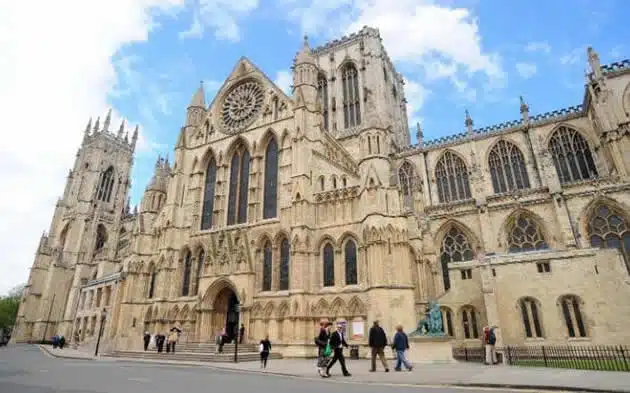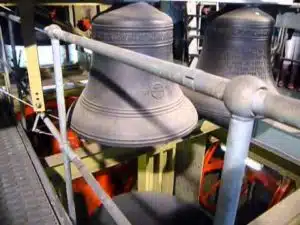One of the largest Gothic Cathedrals in Northern Europe, the Cathedral and Metropolitical Church of Saint Peter in York, or as we know it ‘York Minster’ began construction in 1220 to what we see and enjoy today. Archbishop Gray and the Dean and Chapter decided to rebuild the Norman Minster on a scale to rival Canterbury.
However, York Minster’s history is a very long one so below are 10 facts to give you a quick potted history!
- The core purpose of the Minster, like all churches, is as a place for the worship of God in the Christian tradition.
- York Minster is the largest medieval cathedral in Northern Europe and took 252 years to build.
- The Archbishop of York is appointed by the crown to be head of the Church of England in the Northern Province. His title is Primate of England.
- The Minster has 128 stained glass windows, containing in the region of 2 million separate pieces of glass.
- When the Minster was completed in 1472, an average craftsman was paid 6d, today 6p would keep the Minster open for around half a second.
- The central tower weighs 16,000 tonnes. On a very clear day you can see Lincoln Cathedral 60 miles away.
- Since 627 there have been 96 Bishops and Archbishops of York. Cardinal Wolsey was Archbishop of York for 16 years but never set foot in the Minster!
- The Minster holds around 1,750 religious services a year.
- The restoration of the West Front was completed in 1999. The work took 10 years to complete at a cost of 4.3 million.
- The Minster employs 15 masons and carvers who constantly maintain the fabric of the building.
York Minster Bells
The origins of Great Peter and the history of the proposed clock chime.

However after the great fires of 1829 and 1840 nothing remained of the Cathedral’s clock or chiming mechanisms and in 1844 an ambitious scheme was launched to remedy this situation. The first phase of this scheme involved casting for the Minster, ‘the largest bell in the Kingdom’ as the great new clock bell.
A public subscription was launched for £2000 and Great Peter was cast at the Whitechapel Bellfoundry in London.
The new bell was taken to The Baker Street Bazaar in London for exhibition with the purpose of raising further money. The Illustrated London News in 1845 wrote: “The proceeds from such an exhibition are to be devoted to the purchase of a clock and quarter bells, to be placed in the same tower as the large bell.”
However costs rose again and this ambitious project was abandoned. From that time to the present various attempts have been made to complete the scheme. The last serious attempt was made by Canon Henry Edward Nolloth who wanted the completion of the scheme to mark the 1300th anniversary of the foundation of the Cathedral in 1927. He succeed in having Great Peter re-cast to produce, what is undoubtedly the finest bell in the UK. However this appeal still did not raise enough money to buy the missing quarter bells and clock chiming mechanisms and this scheme remained incomplete.
The new appeal, launched in April 2000, finally allowed for the casting of six quarter chime bells to match Great Peter, together with all chiming mechanism to sound the new bells on the quarter hours.
The new bells
The bells are made from bell metal which is a mixture of copper, tin and various trace elements. The largest bell is nearly 6ft in diameter and weighs three tonnes and the smallest bell weighs just under one tonne. By comparison Great Peter weighs just under 11 tonnes.
Each bell sounds a different note ranging from Bb to G to complement the sound of Great Peter in Eb. The collective sound produces the hymn tune ‘York’ which can be heard in sections on the quarter hour and in full on the hour just before Great Peter chimes the hour bell.
Image from with the John Taylor Bell Foundry, Loughborough The chimes are sounded mechanically by solenoid hammers operated from a centralised computerised control panel.
The bells were made at the John Taylor Bell Foundry in Loughborough where Great Peter was re-cast in 1927.
In August 2000, a new six-bell clock chime was installed in the north-west tower to celebrate the life of Her Majesty Queen Elizabeth the Queen Mother.
The idea of installing a clock which struck the hours on Great Peter was one of long standing, and it had been suggested several times from the nineteenth century onwards but never accomplished due to the high cost. In 2000 the ambition was finally realised, with the installation of the six new quarter bells and an electronic clock which strikes the quarters on the six new bells and the hours on Great Peter.
The quarter chime was specially composed for the Minster, and is based on the hymn tune “York”.
The Minster’s clock chime is the deepest-toned in the country, taking the title from that of the Nottingham Council House by a narrow margin.
York Minster Bell Ringers
Almost certainly there have been bells in York Minster since its foundation; records of them start in the fourteenth century. The bells have been rung in a way we would recognise today by a team of laymen since the early seventeenth century.
Who rings the bells?
The bellringers at York Minster – known since the mid-nineteenth century as “The York Minster Society of Change Ringers” – take pride in a very high standard of ringing, and are privileged to ring on one of the greatest rings of bells ever made. The band of ringers are volunteers from a variety of backgrounds and ages. To find out who they are, click here.
What does bellringing involve?
English change-ringing is a highly skilled activity. The animation on the left shows how bells swing through a complete circle: a good bellringer can balance tons of metal then swing the bell round to cause his or her bell to strike at a given moment with an accuracy of hundredths of a second.
How does change-ringing work?
Bellringing is mathematical: each bell is numbered from the one producing the highest note to the bell producing the lowest note and the bells are rung according to a predetermined pattern which creates different combinations, or “changes”. Bellringers have to learn these patterns – called “methods” – by heart. Good methods produce pleasing sequences of musical changes.
A “Peal” to a bellringer means a piece of bellringing of at least 5000 changes where no change is repeated. On twelve bells there are 479,001,600 possible changes! At York Minster, 5000 changes represents between 4 and 4½ hours continuous ringing.
More Information
Why not take a look at more of Yorks attractions and events in our other York tourism and travel information guides. We hope that you find something new to do in York the next time you are visiting or if you live in this great city, something to do this weekend!



